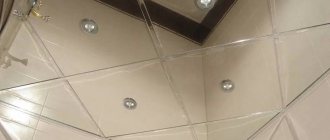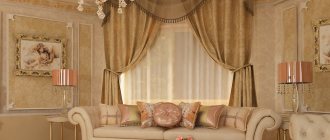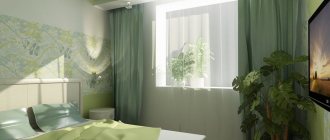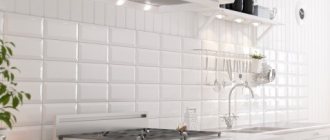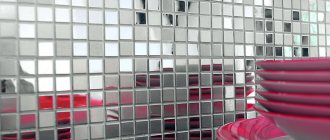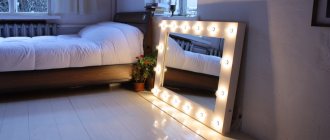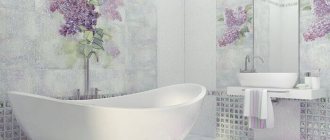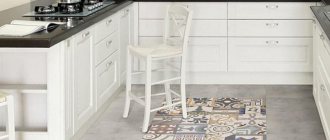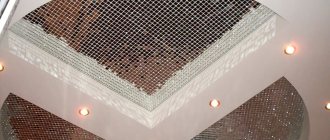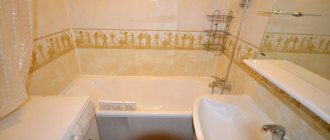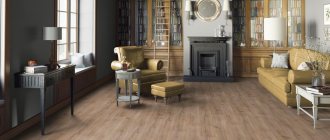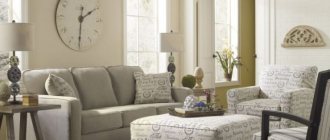The photo shows the interior of a living room in a loft style; one of the walls is decorated with mirror tiles.
The reflective surface can be applied to almost any material - plastic, foil, ceramic, polymer or metal plates. In addition, the metal can be processed in such a way that it will have a mirror effect without additional coating.
Types of mirror tiles
Interior tiles with a reflective surface are usually made of either glass or durable plastic such as polystyrene. There are a huge number of manufacturing options:
- flat and smooth surface, such tiles create almost invisible joints;
- tiles with bevel, it is convenient to install;
- tiles with an effect that imitates metal, for example, gold, silver, chrome or polished bronze;
- tinted, having a faint tint;
- ornamented tiles (have a pattern obtained by sandblasting);
- decorative, decorated with drawings or having three-dimensional images or a textured surface.
Main types
Even tiles made from the same material can differ significantly from each other. Among the most popular options are:
- Smooth mirror tiles without any relief. When laying it, the joints are almost invisible, which makes it possible to create a solid mirror surface, not limited by the shape of a standard mirror. This finish will fit perfectly into modern interior styles (hi-tech, minimalism).
- With facet. A slight bevel of the edges (chamfer) of such mirror tiles greatly facilitates installation, but most of all this type is valued for its ability to create a complex surface that reveals the full potential of the interior. Mirror tiles with bevels look expensive and elegant in the interior, giving any room a noble and luxurious look, and the light refracted on the edges creates a lot of glare. Ideally, such decor will complement classic interiors, especially those made in palace or baroque style, as well as neoclassical and eclectic ones.
- With imitation of a metal surface. Polished bronze, copper, silver, gold, chrome will fit perfectly into both modern and classic interiors. There may be patina or other “traces of time” on the surface.
- Tinted mirror tiles, in which the color of glass or amalgam can be any shade - from smoky gray or beige to rich pink or black.
- With an image. All kinds of ornaments, designs and patterns on such tiles are obtained by sandblasting or using a laser. This option will give the interior individuality and expressiveness.
- With a textured surface. Volumetric designs, pronounced texture or unusual relief will serve as an ideal decor for a wide variety of interiors.
Interior design features
The main thing when using a mirror surface is to maintain a sense of proportion. Too many reflective elements can negatively affect the nervous system. In addition, mirrors located opposite each other create the feeling of a tunnel going into infinity, which has a depressing effect on the psyche.
You can use tiles on two surfaces that are adjacent to each other, for example, one of the walls and the ceiling. However, even in this option, it is better for the tiles to be different: for example, on the wall it can be patterned, and on the ceiling it can be smooth, but with a tint.
Tip: In the interior, designers recommend combining areas decorated with mirror elements so that they differ in the degree of reflection and are at different levels relative to the observer. However, do not forget that light sources reflected in mirrors can negatively affect your vision and tire you. A good solution is to use frosted lamps or LEDs next to the mirror elements.
The ceiling, lined with mirror tiles, visually rises, increasing the height of the room. However, at the same time, this gives rise to the effect of an “inverted” room, especially if the entire ceiling area is lined with mirrors. Therefore, usually the mirror surface only partially occupies it. An important point is also what will be reflected in the ceiling - therefore, increased demands are placed on the interior of the room in general and on the flooring in particular.
Visually “raising” the ceiling with the help of mirror tiles makes sense in small rooms; the interior of a large room with high ceilings will look too cold and empty with such a finish.
Mirror floors are used less often in interiors. It is very important that what is reflected in them does not spoil the interior. In addition, if there is a mirrored floor in the apartment, the use of other reflective materials is not recommended. Do not confuse a mirror floor with “mirror” parquet. The latter is just ordinary parquet, coated with reflective varnish on top.
Mirror tiles in the interior go well with regular tiles, and the joints between them can be covered with moldings made of plaster or wood.
Composition Basics
To make the interior look harmonious, it is better to use mirror tiles to focus attention on one of the walls or ceiling, column or wall. In this case, reflective elements can occupy both the entire area and individual areas.
Mirror tiles are durable, chemical resistant and waterproof
Bathroom wall decor with mirror tiles in small fragments
Cleaning mirror tiles is easy and simple
Advice! For mirror tiles to work to attract and reflect light, they should be placed opposite windows, lamps, and supplemented with lighting.
An interesting effect can be achieved if you cover adjacent surfaces with mirror tiles, for example, a wall and a ceiling or two adjacent walls. But in this case, it is recommended to use products of different types (faceted and contrasting shades, or smooth and patterned).
Hallway design
The placement of mirrors in the entrance area is a requirement for convenience. Moreover, it is better if the person is completely reflected in it. Therefore, in the interior of the hallway, the use of mirror tiles on one of the walls would be quite appropriate.
Eastern traditions, in particular the teachings of Feng Shui, prohibit placing mirrors opposite the entrance; it is believed that in this way money flows cannot enter the house. It is better to tile the side walls - it will replace the traditional mirror. If the hallway is long and narrow enough, you should not lay out the back wall with mirror tiles - the room will seem even longer and narrower, which does not add coziness.
Photo in the living room
If the living room is zoned with a multi-level ceiling, it would be appropriate to decorate some parts of it with mirror tiles. Another interior design idea is to completely tile one of the walls. This will expand the room and highlight its details.
You can also use the property of mirrors to double nearby objects. Place several indoor plants near the wall decorated with mirror materials - it will seem that there are many more of them. A glass display case with beautiful dishes, placed near a mirrored wall, will also “double.”
The photo shows a living room interior in a classic style; mirror surfaces help to visually enlarge a small space.
How to make it yourself
If there is an unfilled area of any surface in your home, try to revive it yourself with a mirror mosaic made by yourself. You can involve the whole family, especially children, in this exciting process.
To do this, you will need an old mirror, which must be cut into pieces using a glass cutter. These can be fragments of different sizes and shapes - a matter of your taste and your imagination. The main thing is to fold them correctly to create a beautiful ornament.
Each piece should be sanded with an emery block. Sand the corners especially carefully so as not to injure yourself during the work. The result should be a lot of mirrored pieces with dull edges. To glue a homemade mosaic you will need several different tools:
- PVA glue or “liquid nails”. The latter are better, because they will not let it break;
- putty;
- plasticine.
In addition, you will need latex putty, a silicone tube with a tip, and a gun for squeezing the composition out of the tube.
How to glue on the wall
If you simply coat the fragment with PVA glue and attach it to the surface, it will not stick. Therefore, we do this: put a piece of plasticine or putty on the back side of the mirror chip, press it down and make a recess into which we add a drop of glue. Press the piece to the surface. While the plasticine holds the mirror, the glue has time to dry. You need to try not to get any excess on the mirror, otherwise its reflective layer will be damaged.
After laying out the mosaic pattern over the entire surface, wait a day or two for the glue to dry completely. Then start grouting the joints. This procedure is performed using putty. If the mirror pieces are of the same shape, then grouting can be done using a small rubber spatula. Otherwise, use an empty silicone tube, which is filled with putty. It is better to squeeze out the composition with a special gun. But if you don’t have one, then the handle of a regular hammer will do.
Finally, remove excess putty with your index finger. When everything is dry, wipe the mosaic with a damp sponge and then with a wad of regular newspaper.
A composition made of a mirror mosaic can be decorated with additional elements: beads, beads, sparkles, etc. They just need to be pressed into the putty that has not yet cooled down.
Mirror mosaic can be easily dismantled if necessary. Moreover, the pieces can be reused.
Country style house.
Read this article on how to paint plasterboard walls.
Types of putties: https://trendsdesign.ru/materialy/shpaklevka/osobennosti-shpatlevaniya.html
Kitchen decoration
Panels made of mirror tiles or mosaics are appropriate both in the interior of the kitchen and in the dining area. Disadvantage: in rooms where food is prepared, all surfaces quickly become covered with a greasy coating, especially if there is no hood, and this coating is especially noticeable.
Production and technical specifications
Mirror tiles are made differently from classic ceramic tiles. This is due to the structural features of the product. The manufacturing process of such material is automated. The warp is made by cutting large sheets into uniform segments of the desired shape and size. The mirror side is made using the damping method. Crystalline substances are added to glass melted at high temperatures, due to which a characteristic shine appears. The cut fragments are processed on a grinding machine and polished.
If the tiles are made from polystyrene, they are much easier to cut and paint. However, this option is no longer so environmentally friendly and safe. All designs and ornaments on surfaces are applied by sandblasting.
Bedroom ideas
In the bedroom interior, it is recommended not to use mirror tiles opposite the bed and on the ceiling. Finish one of the front walls or the wall behind the headboard if you want to get a modern and aesthetic interior. However, for some people, having large reflective pieces in the bedroom can make you feel awkward, so start by placing a large mirror against the wall and assess how comfortable it is for you.
Children's room
Mirror tiles are inappropriate in the interior of a children's room - they break quite easily, which can lead to injuries. Instead, you can use a self-adhesive film on the ceiling - it will reflect the weak light of the night light and create soft diffused lighting for those children who do not like to sleep in a dark room.
Bathroom
In the interior of bathrooms and toilets, mirror elements can look very impressive. These are those rooms in which almost the entire surface of the walls can be lined with it. The only inconvenience is that when using hot water, the tiles fog up.
Passage areas
A corridor, a passage from room to room, or a staircase in a house are not the most illuminated places, so a mirror surface, especially with proper lighting, would be very appropriate. The original option is to decorate the risers with tiles. In this case, the steps seem to be floating in the air, and the staircase itself is very light.
